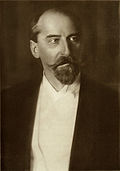| Prime Minister of the Republic of Estonia | |
|---|---|
| Eesti Vabariigi peaminister | |
 | |
| Government of Estonia | |
| Style | Mister Prime Minister (informal) His Excellency (diplomatic) |
| Type | Head of government |
| Member of | European Council |
| Residence | Stenbock House |
| Appointer | President |
| Term length | No term limit |
| Inaugural holder | Konstantin Päts |
| Formation | 24 February 1918 |
| Abolished | 1940–1991 |
| Salary | €7303 monthly [1] |
| Website | https://valitsus.ee |
 |
|---|
The prime minister of Estonia (Estonian : peaminister) is the head of government of the Republic of Estonia. The prime minister is nominated by the president after appropriate consultations with the parliamentary factions and confirmed by the parliament ( Riigikogu ). In case of disagreement, the parliament can reject the president's nomination and choose their own candidate. In practice, since the prime minister must maintain the confidence of parliament in order to remain in office, they are usually the leader of the senior partner in the governing coalition. The current prime minister is Kristen Michal of the Reform Party. He took the office on 23 July 2024 following the resignation of Kaja Kallas.
Contents
The prime minister does not head any specific ministry. Rather, in accordance with the constitution, the prime minister supervises the work of the government. The prime minister's significance and role in the government, and their relations with other ministries, often depend on the position of the party led by the prime minister relative to its coalition partners, and on how much influence the prime minister possesses within one's own party. If the prime minister has a strong position within one's party, and the government is made up solely of representatives of that party, the prime minister can enjoy considerable authority. In all crucial national questions, at least formally, the final word rests with the parliament as the legislative power.
Unlike counterparts in other parliamentary republics, the prime minister of Estonia is both de jure and de facto chief executive. This is because the constitution explicitly vests executive power in the government, of which the prime minister is the leader. In most other parliamentary republics, the president is at least nominal chief executive, while bound by convention to act on the cabinet's advice.





















